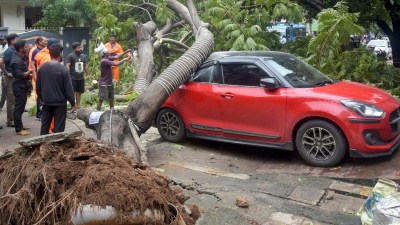Idols, coins, seals: Latest finds at Purana Qila excavation site
The artefacts recovered — ranging from idols of Hindu deities to over a hundred coins and almost three dozen seals among others — will be showcased as an Open Air Site Museum at the fort.
 Union Minister for Culture G. Kishan Reddy during his visit to the Purana Qila excavation site, in New Delhi, Tuesday, May 30, 2023. (PTI Photo)
Union Minister for Culture G. Kishan Reddy during his visit to the Purana Qila excavation site, in New Delhi, Tuesday, May 30, 2023. (PTI Photo)Excavations at Purana Qila, where the ‘sixth city’ of Delhi once stood, have so far revealed nine cultural levels and a continuous history spanning over 2,500 years.
The artefacts recovered — ranging from idols of Hindu deities to over a hundred coins and almost three dozen seals among others — will be showcased as an Open Air Site Museum at the fort.
 Terracotta plaque of Gaja Laxmi, Mauryan-period ring well are among recoveries
Terracotta plaque of Gaja Laxmi, Mauryan-period ring well are among recoveries
Minister of Culture and Tourism and Development of Northeast Region, G Kishan Reddy, made an announcement to this effect following his visit to the site to inspect ongoing excavation work, which was first attempted over six decades ago. “This is the only site in Delhi-NCR where one can witness the continuous history of Delhi from the Pre-Mauryan to Mughal period through the excavated remains. The findings showcase the rich cultural heritage of our country,” Reddy said.
“Purana Qila will be reopened, and the excavated remains will be preserved, conserved, and provided with a shed. The site will be showcased as an Open Air Site Museum, allowing visitors to experience the rich historical legacy of Delhi,” he announced, adding that these will serve as a point of attraction for G-20 Summit delegates.
As per the Ministry of Culture, the ongoing leg of excavation work, which was initiated in January, aims to establish “a complete chronology of the site”, which has yielded artefacts
from different historical periods: Pre-Mauryan, Mauryan, Sunga, Kushana, Gupta, Post Gupta, Rajput, Sultanate and Mughal.
Currently, after reaching a depth of 5.50 metres, according to the Ministry, structures from early Kushana level have been exposed, and the excavation is expected to provide further insights into the ancient city of Indraprastha.
The ministry listed a stone image of Vaikuntha Vishnu, a terracotta plaque of Gaja Laxmi, a stone image of Ganesha, seals and sealings, coins, terracotta figurines, beads of various stones and a bone needle among the notable recoveries from the site. “These artefacts, along with pottery and other antiquities, offer valuable insights into the ancient civilisation and trade activities at the site… More than 136 coins and 35 seals and sealings have been discovered from a small excavated area, indicating the site’s pivotal role as a centre for trade activities,” the ministry stated.
Purana Qila — which served as an internment camp for Japanese civilians of British India during the Second World War and as a refugee camp following the Partition — has witnessed multiple excavations in the past.
Padma-awardee Professor BB Lal conducted excavations in 1955 and 1969-73, followed by excavations led by Dr Vasant Kumar Swarnkar of the ASI in 2013-14 and 2017-18.







